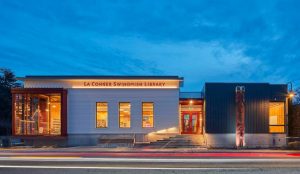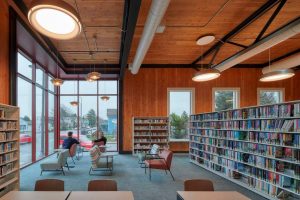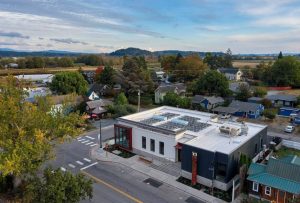
A public library in La Conner in Skagit Country, Washington, achieved the goal of uniting two Indian Tribal Communities, while the cross-laminated timber (CLT) structure of the library contributed to the project’s sustainability outcomes.
Although La Conner and the Swinomish Indian Tribal Community are physically adjacent, they have long been separated by history, culture, and the complex legacies of settler colonialism. During the library’s planning process, located about 113 km (70 mi) north of Seattle, the La Conner Regional Library District formed a project-altering partnership with the Swinomish Indian Tribal Community, resulting in the community becoming heavily involved in the project and one of its largest benefactors.

To represent La Conner and the Swinomish Indian Tribal Community coming together, the new library was renamed the La Conner Swinomish Library. Further, a tribal member took a seat on the library’s board of directors and BuildingWork, the Seattle-based architect for the project, invited the Swinomish Indian Tribal Community to join the design process, honoring the unique partnership between the town and the tribe.
At the library’s entrance stands a traditional story pole designed and crafted specifically for the new library by Swinomish elder and master carver, Kevin Paul.
CLT, fully exposed in the library’s interior, creates a warm and inviting environment. The carbon-sequestering material contributes to the project’s Leadership in Energy and Environmental Design (LEED) silver certification, and as one of the first publicly funded buildings to utilize CLT for the entire structure, the project demonstrates what this emerging construction technology can do.

Other sustainable design strategies include extensive use of daylighting, onsite power generation with a rooftop photovoltaic (PV) system, a highly efficient building envelope and HVAC system, electric vehicle charging stations, and the use of non-toxic materials and finishes throughout.
“When there are common interests and goals, native and non-native communities can find ways to work together and build relationships that help each other grow,” says Swinomish Tribe Senator, Brian Wilbur. “That is what Swinomish and La Conner did with the construction of this library and our communities have grown closer because of it.”
“The La Conner Swinomish Library may be one of the first publicly funded buildings to utilize CLT for the entire building structure, and this project demonstrates what this emerging construction technology can do,” says Matt Aalfs, AIA, principal architect and BuildingWork founder.
